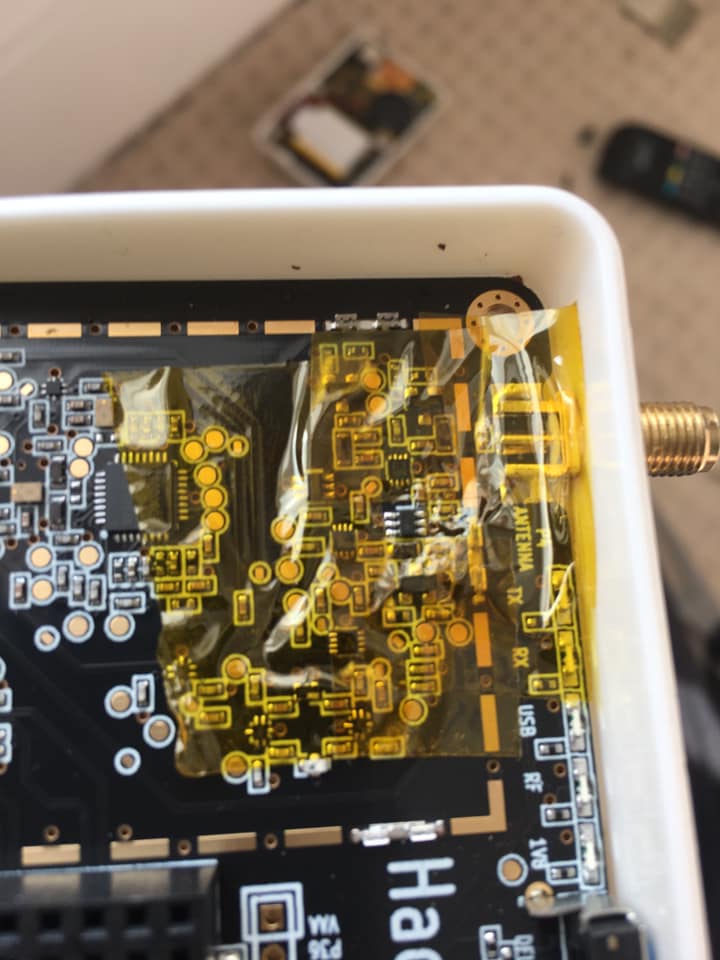Table of Contents
The MGA-81563 can be damaged easily, but you can buy (relatively cheap: https://s.click.aliexpress.com/e/_Dl4U7Yl) and replace them yourself. For more information about this procedure, please check https://www.onesdr.com/2020/04/09/how-to-fix-a-broken-hackrf/
The previous link has a very good reference picture:
RX problems
If you find on a strong signal such as an broadcast FM station that you select Amp as "0" and you get a signal and then select Amp "1" and you do not then this is a good sign that the RF Preamplifier u13 (MGA-81563) is damaged. This can happen if you use a stronger transmitter near to your HackRF.
It is possible to replace the damaged IC with simple tools (soldering iron, solder wick). First solder flood the damaged component to remove it, preferably protecting the surrounding. Clean the pads and replace the component:

TX problems
The same component is used for TX, which also can be damaged. Below is an example of the replacement procedure. First remove and clean the pads. This can be done with hot air or normal soldering iron:
For the orientation, you could use the text of the chip itself. It should be "up", pointing to the antenna jack of the HackRF:
This file contains Unicode characters that might be confused with other characters. If you think that this is intentional, you can safely ignore this warning. Use the Escape button to reveal them.
How to collaborate
How to ask questions correctly
User manual
- First steps
- Usage cautions
- Intended use and Legality
- Features
- PortaPack Versions (which one to buy)
- HackRF Versions
- Firmware update procedure
- Description of the hardware
- User interface
- Powering the PortaPack
- Troubleshooting
- Won't boot
- Config Menu
- Firmware upgrade
- Diagnose firmware update in Windows
- Receive Quality Issues
- No TX/RX
- TX Carrier Only
- H2+ speaker modifications
- Dead Coin Cell Battery
- Factory Defaults
- SD card not recognized by PC with the SD-card over USB selected
- DFU overlay
- Full reset
- SolveBoard
- How to Format SDCard
- What if I don't like some of the apps
- Applications
Misc
Developer Manual
- Compilation of the firmware
- Compile on WSL with ninja
- How to compile on Windows faster with WSL 2
- Using Docker and Kitematic
- Docker command-line reference
- Using Buddyworks and other CI platforms
- Notes for Buddy.Works (and other CI platforms)
- Using ARM on Debian host
- All in one script for ARM on Debian host
- Compile on Arch based distro (exclude Asahi)
- Dev build versions
- Notes About ccache
- Create a custom map
- Code formatting
- PR process
- Description of the Structure
- Software Dev Guides
- Tools
- Research
- UI Screenshots
- Maintaining
- Creating a prod/stable release (Maintainers only)
- Maintaining rules
- Development States Notes
Hardware Hacks
Note
The wiki is incomplete. Please add content and collaborate.
Important
- This is a public wiki. Everything is visible to everyone. Don't use it for personal notes.
- Avoid linking to external tutorials/articles; they may become outdated or contain false information.